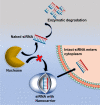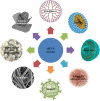Oral delivery of RNAi for cancer therapy
- PMID: 36971908
- PMCID: PMC10040933
- DOI: 10.1007/s10555-023-10099-x
Oral delivery of RNAi for cancer therapy
Abstract
Cancer is a major health concern worldwide and is still in a continuous surge of seeking for effective treatments. Since the discovery of RNAi and their mechanism of action, it has shown promises in targeted therapy for various diseases including cancer. The ability of RNAi to selectively silence the carcinogenic gene makes them ideal as cancer therapeutics. Oral delivery is the ideal route of administration of drug administration because of its patients' compliance and convenience. However, orally administered RNAi, for instance, siRNA, must cross various extracellular and intracellular biological barriers before it reaches the site of action. It is very challenging and important to keep the siRNA stable until they reach to the targeted site. Harsh pH, thick mucus layer, and nuclease enzyme prevent siRNA to diffuse through the intestinal wall and thereby induce a therapeutic effect. After entering the cell, siRNA is subjected to lysosomal degradation. Over the years, various approaches have been taken into consideration to overcome these challenges for oral RNAi delivery. Therefore, understanding the challenges and recent development is crucial to offer a novel and advanced approach for oral RNAi delivery. Herein, we have summarized the delivery strategies for oral delivery RNAi and recent advancement towards the preclinical stages.
Keywords: Bioengineering; Cancer; Oral RNAi; Oral medicines; RNAi therapeutics.
© 2023. The Author(s), under exclusive licence to Springer Science+Business Media, LLC, part of Springer Nature.
Conflict of interest statement
The authors declare no competing interests.
Figures








References
Publication types
MeSH terms
Substances
Grants and funding
LinkOut - more resources
Full Text Sources
Medical

